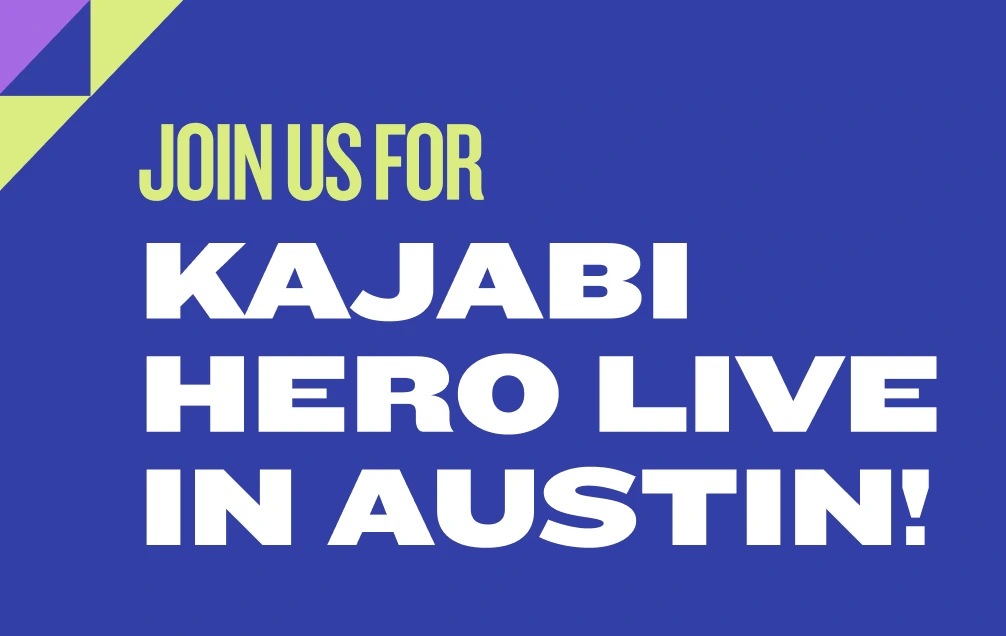
How to expand your audience to include Spanish speakers
Get free expert insights and tips to grow your knowledge business sent right to your inbox.
Whether you’re just opening an online business or are a long-time member of the creator economy, if you’re ready to expand your market, consider selling online courses in Spanish.
Why Spanish?
Nearly 560 million people around the world speak Spanish, 471 million as native speakers. That makes Spanish the second-largest population of native speakers in the world, behind Mandarin.
And don’t think you need to be an international business to find your Spanish speaking customers. They’re already in your market. The United States, for example, is the second-largest Spanish-speaking country when you count native speakers, heritage speakers, and second-language speakers.

Inclusive marketing — marketing to other cultures and languages — isn’t just a smart choice for the growth of your business. It’s becoming a necessary choice as well.
Everything from customer service to traditional brick-and-mortar signage is becoming bilingual. If your business doesn’t include other languages and cultures, it will be quickly left behind.
But before you start churning out campaigns a todo gas (at full throttle), it’s important to understand that attracting a Spanish-speaking audience to your course or membership isn’t merely a matter of having your website text professionally translated to Spanish and then clicking Publish.
If you want to sell online courses in Spanish, you have to recognize the cultural differences and nuances that go beyond just adapting your content into Spanish for Spanish speakers.
There is no one definitive Hispanic or Latino culture, but rather a combination of diverse dialects, values and mannerisms — things that can’t always readily be demonstrated and understood through words alone.
Here’s what to keep in mind if you want to sell online courses in Spanish.
Understand the differences between Hispanic vs. Latino
There’s some debate in terms of labeling something Hispanic or Latino. These terms are often used interchangeably to define a person’s race, but the reality is not quite that simple.
Hispanic refers to people who speak Spanish or people who are descendents of people from Spanish-speaking countries. Simply put, it’s a blanket term to refer to a person who speaks the same language as their predecessors.
Latino (and Latina) on the other hand, is a geographic term that specifically refers to people from Latin America, Central America, South America, and the Caribbean.
To further muddy the waters, someone can be Hispanic but not Latino, for instance, if they or their ancestors came from Spain. Likewise, Brazilians are considered Latino, but not Hispanic, because Portuguese is spoken in Brazil, not Spanish.
Confused yet? Just remember that Hispanic is a term that refers to a group of people based on a shared language, whereas Latino refers to them by geography. It’s an important distinction to keep in mind if you want to sell online courses in Spanish and target the Spanish-speaking market
Localize the language
Although millions of people speak Spanish, it’s important to note that the language varies from country to country, and even region to region. Although they’re mutually understood, some words and phrases can mean something completely different from one country to the next.
Based on how someone dresses and speaks, it’s immediately clear where they’re from, not just geographically, but also societally.
For example, a fresa in Spain is a strawberry, but in Mexico, it’s slang for a stuck up, wealthy kid (what we might call preppy in English), and in Argentina, the word for that fruit is frutilla.
If something is Made in Turkey it is not hecho en pavo (pavo is turkey, but the bird, not the country). And last but not least, don’t trust Google. If you want a real-life illustration of how bad things can go, just ask it to translate paper jam. It will return mermelada de papel, which is paper jam, but the kind of jam you spread on bread.
These are all lost-in-translation mistakes (made by real companies) that could have been avoided had they simply taken the time to consult with a native speaker of the language. It goes without saying that small differences like this can have a big impact on what you’re trying to sell.
Furthermore, the vast majority of Hispanics prefer to use their country of origin to describe themselves, so you’ll likely hear them refer to themselves as Cuban or Dominican rather than Hispanic or Latino.
And by localizing the language to reflect the way the people in that geographical region speak, you’re much more likely to cultivate trust and build a business relationship. Because you take the time to get your translations right, your target market is much more likely to see you as “one of us.”
Be aware of generational and cultural gaps
Hispanics are often divided by marketers into two distinctive groups depending on the degree of cultural integration:
Traditionalists - People who may not speak fluent English and consider their cultural traditions and values to be very important. These values include a clear focus on family, food, and holidays.
If you want to market to this group, use ads that reference these traditional values as well as the idioms and dialects spoken regionally. When you do that, you communicate that your product or service understands what’s important to them. You also send the message that your brand understands and appreciates these same values.
Millennials - These are second-generational Hispanics born in the U.S. who speak both Spanish and English and therefore have adopted customs from both cultures. Although they may be born in the U.S., they still deeply respect and appreciate their heritage, language, and culture.
To market successfully to this group, you need to understand that they straddle two worlds. You need to be able to bridge that gap.
Your ads may be predominantly in English, but it’s never a bad idea to integrate some Spanish phrases or terminology that speaks to a younger, more technologically and socially savvy audience.
Being aware of these differences will help you market more effectively to these audiences. And although one may be more technology-minded and socially savvy in understanding cultural differences, family and core values are a uniting thread between them.
Don’t generalize
You may initially think that your marketing applies to the very broad swath of “all Spanish speakers.” Nothing could be further from the truth. Although the language may be the same, there are distinctive cultural differences between, for example, European Spanish speakers and Mexican Spanish speakers.
Furthermore, there are differences between Colombian Hispanics and Argentine Hispanics. It’s impossible to paint all groups with the same brush in terms of their mannerisms and values, despite the fact that they have a language and some values in common.
If you want to appeal to a specific group of Spanish speakers, you can go the extra mile to make sure that your content, voiceovers, and other media capture that segment’s dialect and nuances. For example, the Chilean dialect is quite different from the Puerto Rican dialect, much like how the Irish accent of English is different from how someone from Texas speaks.
Market like a local
In order to appeal to these market groups, use local faces and phrasing. It’s a good idea to consider using models that come from that country, as the way one group dresses, speaks, and looks isn’t necessarily characteristic of other groups.
What you want to avoid at all costs is falling into the stereotypical habits of generalizing a Hispanic audience as one large amalgamated group. Just as you can easily tell a Britain from a Frenchman from a Spaniard from a German, so too do all of the 33 countries of Latin America have their own unique style.
The fastest way to turn off your Hispanic audience is to portray them stereotypically. If you’re not sure — ask! If it helps your business include them in ways that are significant to them, all the better!
Just because you can market in Spanish doesn’t mean you always should
If you want to sell online courses in Spanish, it’s not enough to create a professional Spanish translation of your home page or landing page, and then call it a day.
You need to be able to show this segment that, just as with your English-speaking audience, their input and concerns are fully understood. That may mean having to hire bilingual customer service or technical support to address customer questions, be available for live chats, be able to break down complex concepts in the course itself, and more.
If you offer coaching, consider partnering with or hiring a native Spanish speaker. They’ll not only help you craft well-targeted, inclusive marketing, they’ll also be able to lead coaching groups in Spanish. You only need to train them in your methodology, so the material is translated accurately.
In short, everything you do in English for your English-speaking audience needs to be carried out in Spanish for Spanish speakers as well. And if you don’t have the budget or staff to make that happen, it may be better to wait until you do before jumping into this marketing pool with both feet. If you’re going to do it, do it right!
Highlighting our Hispanic and Latino heroes
At Kajabi, we’re proud to highlight the Hispanic and Latino Heroes that make up our own user base. Check out their memberships and products to see just how profitable it can be to reach the Hispanic community with what you have to say and sell.
Kevin Trejo

Kevin Trejo is an online marketer who offers a free four-day minicourse that shows users how to build practical, workable sales funnels. He’s also the author of Splash Marketing and his YouTube videos have garnered over 2 million views so far.
i11 Online

Instituto 11 is a business and marketing firm specializing in live 3-day events that educate users on how to grow their sales, web traffic, and followers. They’ve helped thousands of users in more than 20 different countries.
El Arte del Trading

El Arte del Trading (the Art of Trading) takes a look behind the scenes of day trading and swing trading in the financial world, and walks users step-by-step through the process of how it’s done.
Making mistakes and trying to make sense of software “robots” that trade for you can be expensive. El arte del trading helps simplify and streamline the process by turning complete trading beginners into seasoned pros.
The bottom line on how to market to Spanish speakers
Marketing to Spanish speakers doesn’t have to be an enigma wrapped in a mystery. At the core, there are some threads that consistently bridge the gaps that may exist between culture, location, and values.
First and foremost, there’s that sense of pride and nostalgia. There’s an unspoken camaraderie and common understanding between them all. The vast majority believe that their culture and language are very important for future generations of Hispanics in the U.S
If you think the traditionalist trend of marketing only in Spanish will die off when that generation fades away, you’d be sorely mistaken.
The fact is, you can’t translate culture nor emotion. And the solution or success that you’re trying to convey by selling your course to your Hispanic customers is far more important than the words themselves.
In addition, even if your Spanish-speaking prospects don’t primarily use Spanish at home, many Hispanics and Latinos feel that the undercurrent of the language brings them together. It’s just one of many cultural signals that they pick up on and understand as, “This is tailored to me.”
For these reasons, it’s simply not enough to just have a professional Spanish translation done. You have to reimagine your course and how it fits into their values, their goals for their business, their hopes and dreams for today and in the future.
Be aware, some of those values may directly conflict with or be different than your own. And there’s nothing wrong with that.
Just know that marketing to Spanish speakers is not something you can (or should) do in a day. It requires careful, planned thought and purposeful application — just as a marketing initiative or campaign in English would.
By keeping these points in mind, you’ll be able to market to Hispanics and Latinos in a much more natural way. You’ll easily demonstrate that the things they value are also important to you, and you’ll do it in a way that feels authentic, not forced or fake.
¡Buena suerte! (Good luck!)
Find more blog posts by category:
Create Your Product
Build Your Business
Grow Your Business
Kajabi News
Self-Made













